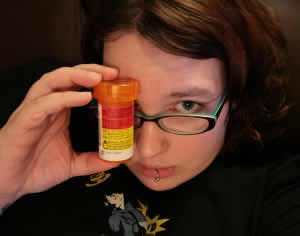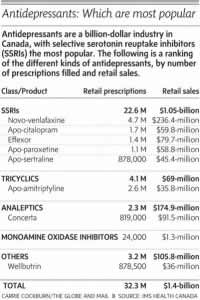Loaded on Pills
How North America Is Losing Its War Against Depression

Via me and the sysop, flickr
By: Jorge T. Armand, Staff Writer
Twitter: Jorge__Armand
Smiling sparse teeth, he looked up in victory over the pool table, with a shaved head, black framed glasses, silver earrings, and a tattooed arm that read ’Product of Influence. That’s how Blaze Convict and I met; I later found out his name is Blaise Convey.
One hot summer afternoon, we were sucking on beers. The phone rang. Blaise got up and answered it; then, silence. His brother had just jumped off of the MacDonald bridge in Halifax, Nova Scotia.
The suicide of Patrick Convey, a major influence in his life, plunged Blaise into a massive depression. Diagnosed with Post Traumatic Stress disorder (PTSD), Blaise was prescribed Paroxetine, an antidepressant commonly known as Paxil.
Launched in 1992 by the pharmaceutical company SmithKline Beecham, now GlaxoSmithKline (GSK), Paxil is used to treat major depression, obsessive compulsive disorder, and anxiety.
On October 16, 2009, The Globe and Mail reported that the most popular antidepressants in Canada are selective reuptake inhibitors (SSRIs). Best known under brand names like Paxil, Prozac, and Zoloft, these drugs excite the brain by releasing serotonin, a neurotransmitter that contributes to feelings of well-being. Paxil is the most potent of these drugs and has the shortest half-life of those in the the SSRIs family.
According to IMS Health Canada, a private company that tracks prescription drug sales, 22.6 million prescriptions for SSRIs were made in 2008, generating a total of $1.05 billion for pharmaceutical companies.
Like thousands of other Paxil users, Blaise reacted terribly to the effects of the drug. Bringing his hands to his forehead, he laments, ’I can barely remember what was going through my mind, mostly because I was completely blank or numb. I wasn’t able to feel a goddamn thing besides fear.
Dr. Srinivasan Pillay is a world-renowned expert in stress and anxiety, Clinical Professor of Psychiatry at Harvard Medical School, and the award-winning author of ’Life Unlocked: 7 Revolutionary Lessons to Overcome Fear. He believes that ’a good physician is always uncomfortable when someone is under medication and never overestimates how much is known about a drug.
Paxil is known to have side effects including, but not limited to: sexual dysfunction, insomnia, sedation, headaches, suicidal thoughts, and an increase in birth defects. Wait, most drugs are said to have some side effects, right? Frighteningly enough, however, it gets worse – the minute you decide to stop taking Paxil.
Back in 1999, when the internet was somewhat primitive, there was no information available about Paxil’s severe withdrawal process. Even within the medical community, little about this issue was well known. One man, who ’couldn’t sleep anyways, due to his Paxil withdrawal symptoms, decided to change that.

Frank Streicher created Quitpaxil.org, the first ever website to assist Paxil users experiencing withdrawal symptoms. The site gathers all available information on the subject of Paxil withdrawal and features an ongoing blog that discusses users experiences with the drug. I was really quite astounded at how quickly it all happened; within weeks, I was inundated with hundreds of letters. At one point, I was getting a hundred letters a day. I mean, it was really just insane. I had to build a bigger website, Frank recalls.
Following the guidelines of Quitpaxil.org, Blaise began to carefully reduce his Paxil dosage. When he finally stopped taking it completely, all hell broke loose.































Share the post "Loaded on Pills"